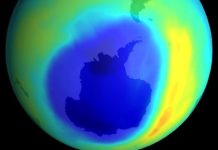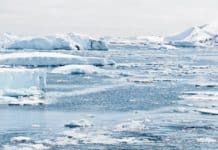
May 22 (UPI) — The chlorofluorocarbon known as CFC-11 is on the rise again, according to measurements by NOAA scientists, and threatens to undermine the continuing recovery of the ozone layer.
The production of chlorofluorocarbons, or CFCs, was fazed out by the Montreal Protocol after researchers showed the chemicals, widely used as aerosols and refrigerants, were responsible for the depletion of the ozone layer, which protects Earth’s inhabitants from harmful ultraviolet radiation.
Scientists with the National Oceanic and Atmospheric Administration monitor the concentrations of a range of problematic chemicals in Earth’s atmosphere.
“We have a number of sites around the world where we send stainless steel or glass canisters for air sampling,” NOAA scientist Stephen Montzka told UPI. “Using air from a clear air sector, over the ocean in many instances, our partners fill the flask, pressurize it, send it back to us and we analyze the contents.”
Scientists use a technique called gas chromatography to isolate and measure the concentrations of chemicals like CFCs in the samples.
Recently, Montzka and his colleagues identified rising levels of CFC-11 in samples collected in Hawaii. They published the results of their latest sampling efforts earlier this month in the journal Nature.
Researchers believe the spike in CFC-11 levels, which first emerged in 2013, is the result of a new source of the ozone-eating chemical, most likely in the region immediately upwind from Hawaii — East Asia.
Montzka and his colleagues know the source is new, but they aren’t certain about its exact origin. East Asia is a large region.
“There is one thing that I can try to do, I can try to isolate that source more precisely,” Montzka said.
There are two ways to do that, according to Montzka: NOAA scientists can reexamine their data, or NOAA can encourage other global research organizations to look closely at their data.
“I have colleagues in China, South Korea and Japan that make measurements across the region, which could help pinpoint the source,” Montzka said. “Hopefully they’ve seen the attention this work has received and they realize the importance of their own work in helping us locate the new source.”
One of the reasons chlorofluorocarbons are so problematic is that they last a long time. The compounds have a lifespan of roughly 50 years, giving them plenty of time to rise to the stratosphere. Once CFCs reach the upper layers of the atmosphere, they can be broken down by ultraviolet solar radiation, releasing chlorine, which eats away at the ozone layer.
Recent studies have shown that the ban on CFCs has led to a reduction of chlorine in the stratosphere, allowing for the recovery of the ozone layer. That recovery could be delayed, however, if new sources of CFCs lead to a longterm rise in atmospheric chlorine.





